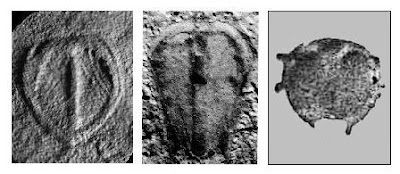From his presentation we learn that there is a group of fossils that may be classified as ancestors of Cambrian trilobites. If this turns out to be true the rather recent discovery is, of course, another major step forward in bridging Ediacaran enigma with the Cambrian explosion of life. Here is just a short quote from Sam's text (check the page itself for full discussion and a very illuminative chart):
Parvancorina: a Precambrian trilobite ancestor?
The similarity of the Precambrian Parvancorina to the Cambrian Chengjiang arthropod Primicaris larvaformis, and a protaspid of a Cambrian trilobite is seen to the left. [Protaspid is an early period in the growth of a trilobite in which larva lacks articulated segments]
All three have an ovoid form, and an anchor-like structure made up of an axial lobe and lateral lobes running along the anterior and lateral edges of the body.
Primicaris was first thought to be a larval naraoid (e.g., Hou & Bergstrom 1997), but it was recognized more recently as taxon in its own right (Zhang et al 2003).
Recapitulating phylogeny, the trilobite protaspid resembles Primicaris.
If the similarity of Parvancorina to Primicaris is more than superficial, it is perhaps the best candidate for an early arthropod in the Precambrian.
The similarity of the Precambrian Parvancorina to the Cambrian Chengjiang arthropod Primicaris larvaformis, and a protaspid of a Cambrian trilobite is seen to the left. [Protaspid is an early period in the growth of a trilobite in which larva lacks articulated segments]
All three have an ovoid form, and an anchor-like structure made up of an axial lobe and lateral lobes running along the anterior and lateral edges of the body.
Primicaris was first thought to be a larval naraoid (e.g., Hou & Bergstrom 1997), but it was recognized more recently as taxon in its own right (Zhang et al 2003).
Recapitulating phylogeny, the trilobite protaspid resembles Primicaris.
If the similarity of Parvancorina to Primicaris is more than superficial, it is perhaps the best candidate for an early arthropod in the Precambrian.
Two Comments
1. The text is again a good example of how research goes on in search of answers to increasingly specific questions as our knowledge increases. The many "ifs" are actually exclamation marks that here is something that should still be verified and studied carefully before we can say that we know.
2. I like very much this sentence in Sam's expert text
"Recapitulating phylogeny, the trilobite protaspid resembles Primicaris."
It is half English, half Latin and as such fully Hebrew to most people.




